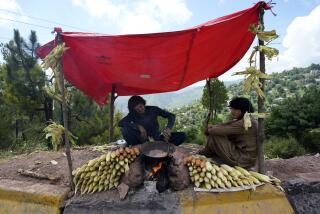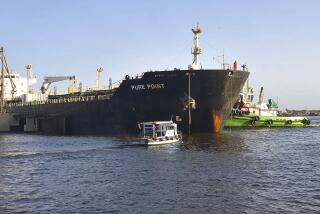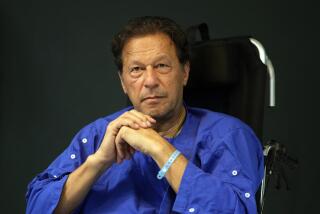International Business : Pakistan’s Leaders Still Need to Take Tough Economic Steps
- Share via
ISLAMABAD, Pakistan — ISSUE: After a year of political tumult mixed with near-economic paralysis, a dearth of hard cash in state coffers and a drop in exports linked to floods and disease, 1994 in Pakistan looks far rosier. But skeptics wonder if Prime Minister Benazir Bhutto dares court the anger of voters and powerful interests by implementing more tough measures needed to transform Pakistan’s economic game.
BACKGROUND: In February, the International Monetary Fund approved a $1.4-billion facility for credit to Pakistan, and a few days later, individual donor nations pledged $2.5 billion in grants and low-interest loans.
Support for Bhutto, who was elected in October, is one reason Western nations are again flocking to assist Pakistan. (The United States is not among them, because of Pakistan’s nuclear program.) Another reason is the reformist line laid down by Moeen Qureshi, an erstwhile World Bank and IMF official who served as caretaker premier from last July until the elections.
Not having to worry about pleasing either the citizenry or parties, Qureshi took harsh but long-overdue measures such as increasing prices for gasoline, electricity and wheat and depreciating Pakistan’s overvalued rupee.
On a much smaller scale, Pakistan’s economy suffers from many of the same maladies as India’s. Protected by high tariff barriers, many industries are lazy and non-competitive. There is a surfeit of regulation and graft.
Birth and illiteracy rates are among the world’s highest. Workers in textile plants are unqualified to use state-of-the-art machinery.
STRATEGY: The 40-year-old Bhutto has embraced Qureshi’s policies on liberalization, privatization and decentralization. Her Cabinet is drafting Pakistan’s eighth Five-Year Plan, which reportedly is being finalized.
“What has to be done is to keep things going, to keep the (government) budget under control, keep monetary policy strict and implement structural changes,” one foreign economist involved in assistance programs to Pakistan said. So, far, he said, Bhutto remains “on the right track.”
To open up the economy and force home-grown companies to be more competitive, the government plans to cut tariffs from a top rate of 92% to 70% in the next fiscal year, then to 45% and 35% in the two ensuing years.
To widen a precariously thin tax base, Parliament passed a wealth levy on the politically powerful farm sector in February, and a separate agricultural income tax is supposed to be enacted by the country’s four provinces.
Those measures are being promoted by international donors because the land barons who chiefly run Pakistani politics (the Bhutto clan included) pay virtually no tax. It’s a novelty to jail someone for tax evasion, but Bhutto has said her government’s inspectors will have a free hand to pursue evaders.
Buoyed by Bhutto’s election win and commitment to the IMF’s three-year austerity and deficit-cutting package, private investors have also become more bullish. Since October, at least $200 million in fresh foreign investment has reportedly flowed into Pakistani stock exchanges, and this year the figure could double.
OUTLOOK: The IMF has advised the government to cut defense outlays, raise utility rates, hike petroleum prices further and take a host of other painful measures to keep the economy on the road to recovery. Those steps carry large political costs, and some Western economists in Islamabad who have seen other Pakistani leaders embrace reform don’t believe Bhutto can follow through.
Economic growth in Pakistan this year is expected to be about 5%--quite respectable in today’s world. The rate would have been higher, but cotton, responsible for 60% of exports, was hit hard in 1993 by the leaf curl virus, and production plummeted to 9.3 million bales from 12.8 million.
This year, cotton is still prey to the disease, and the harvest is expected to drop by almost another 2 million bales.
News is better in other farming sectors: Sugar and rice crops are said to be up over last year’s.
Industry on the whole is doing well, with manufacturing exports--excluding textiles--up 16% over 1993.
More to Read
Sign up for Essential California
The most important California stories and recommendations in your inbox every morning.
You may occasionally receive promotional content from the Los Angeles Times.












